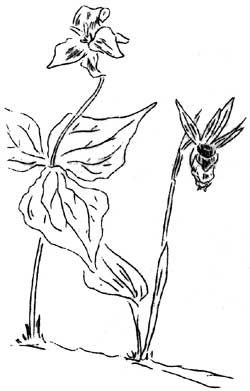
 | ||||||||
The trill of the Varied Thrush and the melodious tinkle of running water - released from nearby snowbanks by the warm sunshine -- heralds the coming of spring. Soon after we find the first of our varied flowers pushing their way from the earth. Coltsfoot and Skunk Cabbage form the vanguard of our floral hosts. They are not very auspicious leaders. Nevertheless they are welcome for they signify the end of the long winter here and the beginning of another colorful season that will last for many weeks and include the flowers of the deep, dank forests of the lower elevations of the park as well as those of the high, rugged windswept crests of the upper ridges far above timberline. Those interested in botany will never tire of the endless variety of plant associations and forms that are prompted by Rainier's altitudinal differences and this park's rugged topography which offers such a variety of habitat. The first flower display of the season graced the porch of the Museum at Longmire on May 26. Nearly twenty species were represented -- all being those native to the lower forests for there is still almost fifteen feet of snow in the sub-alpine meadows. At this time we find in the swampy soils the yellow shoots of the Skunk Cabbage. This plant has an unsavory reputation and a name that keeps alive this prejudice for its really adds considerable life and color to the dull green of its sombre coniferous background at this season. Certainly it attracts its share of attention - particularly from those not familiar with the plant - for its flame shaped spathes appear in great numbers throughout boggy situations. One finds spider webs arranged over the entrance of the spathe of many of these plants for the spider has learned that the putrid odor of the plant is designed to attract certain insects that prefer such an unsavory aroma. The Skunk Cabbage is pollenized by these insects that get about so early - likewise the webs of the spider serve to entangle many of these entomological "early birds" in their meshes and so, also, are the spider's wants provided for by nature. It is a complex, inter-relationship, this dependance of plant and animal life that one sees on every hand at this season. The beautiful Ladyslipper adds interest to the moist woods of the lower elevations. Its relative, the Orchid, that is so pried as a floral gem may be more widely known but after seeing this delicate bloom in its native haunt one feels that, had our native Ladyslipper as good a publicity agent as its more famous relative of distant lands, that it would also be as widely appreciated for its rare beauty. Of course there is the Red-flowering Currant also. With the blooming of this plant come the hummingbirds which pay particular attention to the flaming crimson of this plant's blossoms. Two other species of this same genus will also be found - the Prickly Currant and the "Stink" Currant - which in name and blossom have a negative rather than a positive effect upon the early visitor to the park. 
The rose family is represented by the Salmonberry in this early season. It, as the season advances, will present a succession of bloom in successive higher levels in the park until mid-summer when these first plants to bloom will bear their large, conspicuous - but not too palatable-fruit. The pure white petals of the Trillium sparkle in the dense coniferous forests - several months behind the same species that blooms so early near sea level and an excellent indicator of the fact that as one climbs to higher elevations a corresponding change in plant life similar to a northward journey is found. For a climb of 1000 feet is about equivalent to a northward journey of 300 miles in many ways at least as far as plant and animal life is concerned. Violets - both yellow and blue in several species may be found. Trees are flowering too and we find the Douglas Fir - up to 3000 feet in elevation - brightened by the red pistillate flowers at this time. The Wood Sorrel is abundant in the woods where they carpet the forest floor with their clover-like foliage in great abundance. And so one need not wait for summer if interested in the botany of Mt. Rainier National Park. These early plants offer possibilities which are just as great. | ||||||
| <<< Previous | > Cover < | Next >>> |
vol11-4d.htm
17-Nov-2001